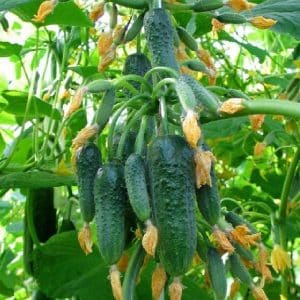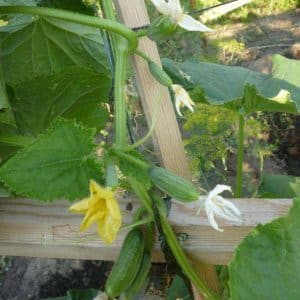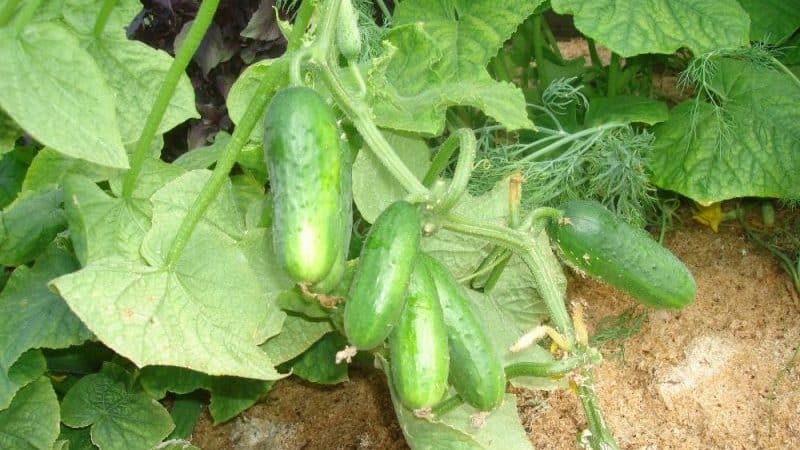A cucumber that has won the hearts of many farmers - “Perfection itself f1” for greenhouses and open ground
Early ripening hybrids of cucumbers allow you to harvest an early harvest and that is why they are so popular among summer residents. These include a culture with the self-explanatory name Perfection itself f1. These cucumbers grow well even in unfavorable conditions at elevated temperatures.
In the kitchen, “perfect” cucumbers are universal: they are used both fresh and prepared.
Description of the hybrid

The very perfection f1 was bred by domestic breeders. It is a parthenocarpic hybrid, meaning the plant does not require pollination to form fruit.
It is characterized by an abundance of fruits on the bushes and a rich harvest. 3-6 greens are formed in each leaf axil. The first fruits ripen within 37–30 days after germination. Cucumbers are resistant to elevated temperatures and harsh conditions and prefer abundant watering.
Distinctive features
The distinctive features of the hybrid include stable and high productivity even in unfavorable summers and uniform ripening of cucumbers.
Features include a shallow root system of small size - for this reason the plant needs frequent and abundant watering. Another important characteristic of the hybrid is its female type of flowering in most ovaries.
Composition, properties, benefits, calorie content
Cucumber consists of 95% structured water that is beneficial for the body. Among vegetables, cucumber takes one of the first places in terms of fiber volume.The dietary fiber it contains helps gently cleanse the intestines and improve its motility.
Cucumber also contains many health benefits:
- beta-carotene;
- vitamins A, B1, B2, C, PP;
- potassium;
- magnesium;
- zinc;
- copper;
- manganese;
- iron;
- chlorine;
- iodine;
- chromium;
- phosphorus;
- sodium;
- folic acid.
The calorie content of cucumber is only 15 kcal per 100 g.
Characteristics
The bush of this hybrid grows upward, and cylindrical fruits are formed in each of its axils. The length of the cucumber reaches 8-10 cm, and the diameter is 3 cm. The surface of the fruit is light green with white stripes. The fruits are covered with many tubercles and hard fluff. The pulp of cucumbers is tasty and sweet. Even if agricultural practices are not followed, cucumbers do not have bitterness.
With proper care, about 30 kg of cucumbers are harvested from 1 square meter. m. Harvesting is carried out daily.
How to grow your own
The hybrid is suitable for growing both in a greenhouse and in open ground. It can be placed into the soil on the site sow seeds or using seedlings.
Planting by seeds and seedlings
Let's consider two methods of planting crops, find out their features and advantages.
Seed method
Because it's a hybrid and not variety, you won’t be able to get the seeds yourself—you’ll have to buy them at a specialized store. Before planting, the seeds are germinated. They begin to be planted in open ground in mid-May, when the soil warms up to +15 °C. Place 2-3 seeds in a hole in the ground 1.5-2 cm deep.
A distance of 15 cm is left between plants, and row spacing is 60 cm. It is not recommended to plant more than two plants per square meter. After planting, cover the ground with film. All weak plants are subsequently removed.
Seedling method
To prepare seedlings, seeds begin to be planted from the second half of March to early April. Peat pots are best suited for this method. This will help in the future not to damage the seedlings when transplanting into the ground. In each pot, place 1-2 seeds in holes 1.5-2 cm deep.
 It is important to ensure a comfortable air temperature for seedlings +25-26 °C in the first days after planting. After the first shoots appear, the temperature is lowered by 3–4 degrees. As soon as the plants have 3-4 leaves, the seedlings are transplanted into open ground.
It is important to ensure a comfortable air temperature for seedlings +25-26 °C in the first days after planting. After the first shoots appear, the temperature is lowered by 3–4 degrees. As soon as the plants have 3-4 leaves, the seedlings are transplanted into open ground.
Suitable soil for future cucumbers should have a temperature of at least +14–15 °C. For this reason, seedlings are planted no earlier than the beginning of May.
To prevent plants from interfering with each other's growth, it is recommended to leave row spacing of 60 cm and a distance in the row of 15 cm. Otherwise, the plants will grow too close to each other and, as a result, empty flowers will form. After planting, the plants are watered with warm water.
Important! In the first days, seedlings are insulated with film or agrofibre to protect them from the cold and speed up rooting.
Growing in stages and care
Experts recommend shaping the plants - their proper development and harvest volume depend on this. It is best to grow a cucumber with one stem. The first 4-5 nodes are blinded, the stem is fixed to the trellis. The cucumber needs support, otherwise some of the ovaries will turn yellow and dry out. Metal mesh or trellises will do.
Since the hybrid has a small and shallow root system, regular watering is necessary for the development of its fruits. Bushes need to be watered at least 2-3 times a week. Gardeners regulate the frequency of watering themselves. At the same time, the soil should not dry out and form a crust.After watering, it is important to loosen the soil, mulch and get rid of weeds.
Important! Use only settled and warm water.
The bush is fed 4-5 times per season with complex fertilizers, which contain nitrogen, potassium and phosphorus. Experienced gardeners recommend fertilizing in the evening, applying fertilizer at the root of the plants. Mullein infusion is suitable for these purposes. Take one part cow dung and let it steep in 5 parts water for two weeks. Before use, the infusion is diluted with water in a ratio of 1:10.
Important! Fertilizers such as “Ammofoska” or “Azofoska” are also suitable for feeding.
Features of cultivation and possible difficulties
Both the seedling method and direct sowing in the ground are suitable for growing the hybrid. With the seedling method of cultivation, the yield of cucumber increases.
Before planting, the seeds are prepared. First, the seed is selected by soaking it in water for 20 minutes. The seeds that have fallen to the bottom are taken for planting, and those that float are thrown away. The selected material is dried at a temperature of at least +20°C.
Important! When planting cucumbers, you should not be guided only by the information about the expiration date on the package. Soak for 20 minutes and check the quality of the purchased material.
Then, to speed up ripening, the seeds are heated. To do this, they are filled with water heated to +55-60 °C for 4-5 hours. After a week, dry in the sun or warm up near the stove or on a radiator.
Potassium permanganate 0.5–1% is used for disinfection. The seeds are soaked in it for 15–20 minutes and then washed with clean water.
The day before sowing the seeds in the ground, they are lured in water. Growth stimulants are added to the water, for example, “Agat-25K” or “Rostmoment”.
Resistance to diseases and pests
Hybrid Sheer perfection f1 resistant to most diseases, but is susceptible to downy mildew. As a preventative measure, plantings are regularly treated with chemicals “Quadris”, “Strobi”, “Topaz”.
Cucumber suffers from pests such as melon aphids, spider mites, slugs, ants and whiteflies. When these insects appear on the site, use “Aktellik”, “Confidor” or other insecticides.
Harvesting and application

It is recommended to harvest the crop daily. After collecting the first offspring, nitrogen fertilizers are applied. You can also water the cucumbers with an infusion of organic matter, such as nettle, manure or droppings.
The fruits of the hybrid Perfection itself f1 can be used in different ways: fresh, in salads, soups and canned.
Important! When canning the fruits do not lose their properties and remain dense and crispy.
Advantages and disadvantages
Hybrid Sheer perfection f1 has a number of positive characteristics:
- precocity;
- rich harvest up to 30 kg per 1 sq. m;
- long fruiting;
- resistance to powdery mildew;
- resistance to high temperatures and worsening weather;
- tolerates shading well;
- moderate branching;
- does not require pollinating insects.
Among the disadvantages of the variety are the following points:
- expensive planting material;
- susceptibility to downy mildew;
- demands on watering;
- the need for regular stepsoning.
Reviews
Among the rave reviews about the hybrid The Sheer Perfection of the f1, there is also an opposite opinion. The reason is a lack of understanding of the conditions for which this cucumber was bred. Despite its Siberian origin, it is not resistant to extreme cold.Therefore, plantings in temperate climates require additional insulation. Gardeners who strictly follow the instructions do not have such problems.
Tatiana: «This year I bought cucumber seeds of the Samo Perfection f1 variety. The cucumbers are wonderful, crispy, and there are a lot of them. Extraordinary beauty."
Marina: “Last year, as an experiment, I planted just a few cucumber seeds. Sheer perfection f1. First of all, I was surprised by the unpretentiousness of the plant. The cucumber grew with virtually no care. Therefore, the next year I decided to plant more cucumbers and grew the bushes more carefully. As a result, we received a record high harvest.”
Andrey: “I grew cucumbers Sheer perfection f1 in open ground. This didn't cause me any problems. As expected, I covered the plants with film. As soon as the first autumn frosts began, I covered the bushes again and thanks to this I harvested until the snow. I especially liked the bright and juicy taste and thin skin of cucumbers.”
Conclusion
Cucumber hybrid Sheer perfection f1 is suitable for amateur gardeners. It is distinguished by its early maturity, productivity and versatility in the kitchen. The hybrid is unpretentious, but to get a harvest, remember the rules: form plants without stepsons, water and fertilize the cucumbers abundantly.